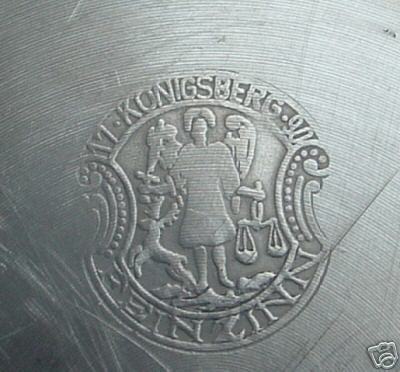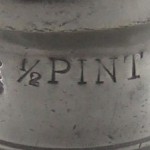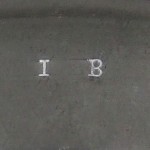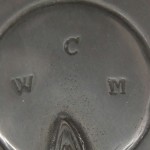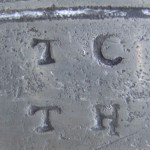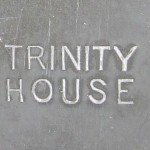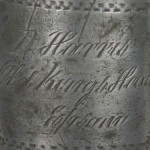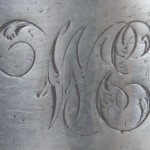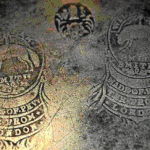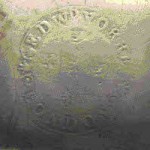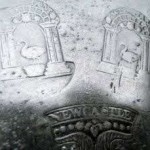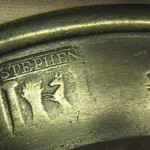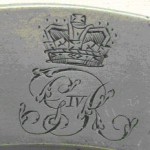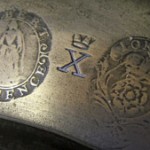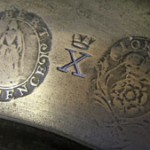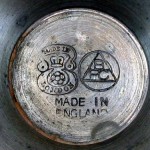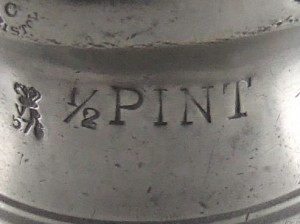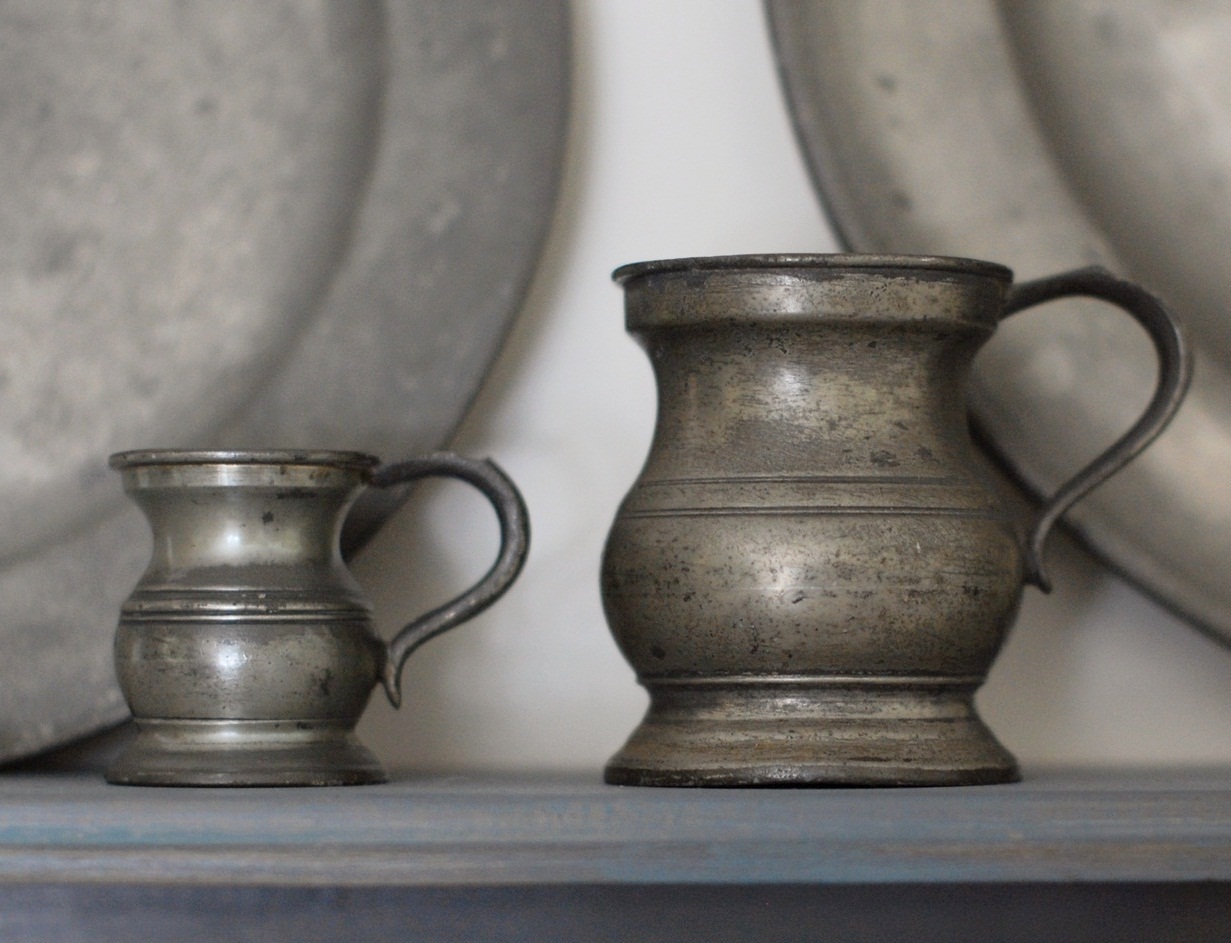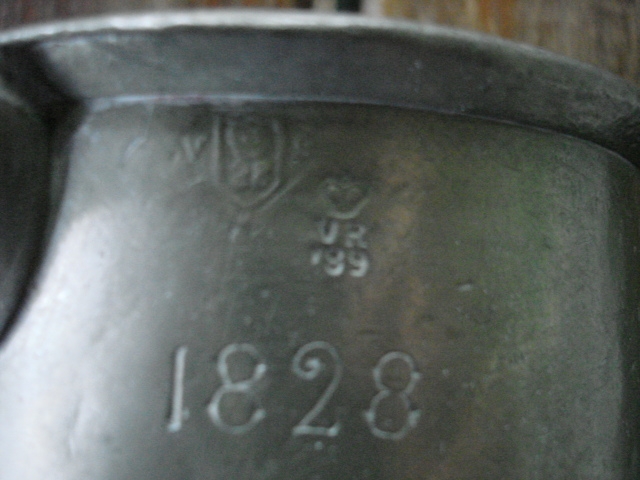- An example of a capacity mark.
- An example of two owners initials.
- An example of three (triad) owners initials.
- An example of four owners initials.
- An example of a housemark.
- An example of owner’s mark. Engraved D.Harris, presumably the Landlord of the Old Kings Head, Epsom
- An example of owners’ marks engraved as a monogram. These are often difficult to read.
- two Touch Marks and ‘London Pewter’ from William Smith of Leeds about 1730
- Remains of two crowned Xs and the Touchmark ofCocks – London – Susannah Cocks 1819-1844
- Touch Mark of Edward Yorke of LondonPewterer from 1732 – 1736
- Two Touch Marks and a Newcastle on Tyne Label from William Hogg 1780 – 1815
- Touch Mark of Stephen Cox – Bristol 1735 to 1761And Crowned quality X mark
- To the Plain Rim of the 1820 Coronation plates of George IV made by the pewterer Thomas Alderson of London (1790-1835) (plain rimmed plate)
- Nice use of Touch Marks by Robert Patience, mostly at Fleet Street, London, Pewterer – one named and the other a crowned rose with a crowned X quality mark, 1737-1776
A touch mark is a pewterer’s “trade mark” and often, but not always, includes the name or initials of the pewterer. In London and Edinburgh pewterers had to record their touch marks on special plates, and we know the names of most of those who did so.
However, that practice was not followed elsewhere, and even in London and Edinburgh pewterers often used touch marks that differed from those they had recorded on the ‘Touch Plates’. So whilst thousands of touch marks have been recorded, we do not always know the pewterers to whom they belong.
Touch marks vary considerably in style and size, and by the 19th century they had often become just a simple name stamp. If a touch mark includes a date, this is the date on which the pewterer set up in business, not the date on which the article was made.
Good early pewter often bears elaborate ownership marks in a raised form, rather like a wax seal. Triads (a triangular formation) of letters stamped on the rim of a pewter plate are generally held to give the initials of the couple who owned it.
Small marks are also found on pewter in imitation of silver hallmarks, and usually consist of four shields (1). The symbols in the shields generally imitate genuine silver marks quite closely-for instance, the figure of Britannia, the lion passant and the leopard’s head – presumably with the purpose of persuading the buyer that the item concerned contained real silver.
After 1826, tankards and measures used in taverns had to carry capacity marks.These were of local design until 1877, after which they were validated by an excise mark consisting of a crown over the monarch’s initials and a code number, denoting the area in which inspection of capacity had been carried out (2).
Pseudo-hallmarks
When brand new and highly polished, pewter looks very much like silver, and many pewterers stamped pseudo-hallmarks on their wares to mimic the officially-approved hallmarks on silver. They can’t have been trying to deceive their customers as they would have known perfectly well what they were buying. It is more likely that the customers wanted the hallmarks so they their visitors would think they were wealthy enough to afford silver!
Whilst hallmarks on pewter have no official significance, they can help identify the pewterer. There are normally four hallmarks, but pewterers from Wigan often used five, whilst very occasionally other pewterers used two, three or six. The hallmarks often include the pewterer’s initials. Sometimes all the hallmarks are the same.
Hallmarks were not used prior to about 1630. With plates, dishes and chargers the position of the hallmarks can help with dating. They were normally on the front of the rim up to about 1730, and thereafter on the back of the well.
Dutch and American pewterers also used pseudo-hallmarks, so the presence of hallmarks is not conclusive evidence that the piece is British.
Quality marks
The crowned rose was used on pewter from the mid 16th century to denote higher-quality metal. Most pewterers had their own variation of the design. By the end of the 17th century pewterers were also using a crowned X to indicate harder alloys, but as time went on all control over the use of both marks was lost and pewterers used them indiscriminately on all their wares. Crowned rose marks can be helpful in identifying pewterers as most used their own variation of the design. Even crowned Xs can sometimes be helpful, although there is less scope for variation.
From the 18th century onwards pewterers also invented their own ‘quality’ slogans such as ‘Superfine Hard Metal’. See the Labels page for some examples.
Before the introduction of the crowned rose, a crowned or uncrowned hammer was sometimes struck on sadware and this is also believed to be a quality mark. However, it is very rare.
Labels
In the 18th and 19th centuries many pewterers put various labels on their wares. Some were essentially advertising slogans, such as “Superfine Hard Metal” to promote the idea that the goods were of a superior quality.
Others such as “Made in London” identified where the pewter was supposedly made, but be warned: this description was applied not only by London pewterers but also by many provincial pewterers, and indeed even by some on mainland Europe. Non-London pewterers used it because traditionally London pewter was considered to be superior.
The words ENGLAND or ENGLISH PEWTER were only used after 1891, following a United States tariff law that required imported goods to bear the country of origin. An amendment of the tariff law in 1909 required the text to be changed to MADE IN ENGLAND, so any piece stamped with this is post-1909. The presence of these marks does not mean the item was actually exported to the US as many makers took the easy route and simply stamped all their wares.
Catalogue numbers
In the 19th and 20th century pewterers often produced catalogues of their wares and put the catalogue numbers on the articles themselves. They are normally simple stamped numbers of three, four or five digits, sometimes with a letter as well. They are most common on wares made of Britannia metal. Do not fall into the trap of assuming that a four digit number like ’1754′ is a date – it isn’t!
Teapots, coffee pots and jugs from Sheffield manufacturers are often stamped with a single digit representing the capacity. Rather confusingly, the digit represents the number of half pints, so ’5′ means 2½ pints.
In the 19th and 20th centuries, workmen in some of the larger businesses stamped their own number (or occasionally letter) on the piece. If a number is too short to be a catalogue number and doesn’t represent capacity, it is probably a workman’s number.
Very occasionally you will find patent or registered design numbers, but these are always preceded by ‘Patent’, ‘Registered’ or something similar. Prior to 1884 you may find the diamond design registration mark rather than a registration number.
Verification and capacity marks
These marks only appear on drinking vessels and measures that are made to a specific capacity.
Capacity marks
A capacity mark such as ‘pint’ or ‘quart’ is self explanatory. Such marks became a legal requirement in 1836. The presence of such a mark does not mean the item is post-1836 as vessels made before then which remained in use after 1836 were often marked retrospectively. Equally, the absence of any capacity mark does not mean the vessel must be pre-1836 as not everyone adhered to the law.
Verification marks
A verification mark signifies that the measure has been inspected by an official Weights & Measures Inspector and found to be of the correct capacity. It became a country-wide legal requirement to stamp all measures with a verification mark in 1835, though some areas such as the Cities of London and Westminster had being do so before this. Until about 1878 each town generally had its own style of mark. From roughly 1879 onwards a uniform style was adopted consisting of a crown, the monarch’s initials (ie VR, ER or GR) and a number which signifies the location. Measures were often inspected several times during their lifetime and thus can carry several verification marks. Sometimes at subsequent inspections the inspector merely stamped a two digit number signifying the year of re-inspection.
For more information on verification marks, see:
Marks and Markings of Weights and Measures of the British Isles by Carl Ricketts and John Douglas 1996, ISBN 0 952 853 302.
Marks denoting the capacity standard
In 1826 the Imperial Standard was introduced to supersede a number of other standards that had been in use until then. In practice a number of regions failed to switch to the new standard until several years later, and indeed non-Imperial standards were still occasionally being used in the late 19th century. The word Imperial on a measure shows it was made to the new standard and is therefore post-1826.
Prior to the compulsory introduction of verification marks in 1835, pewterers often punched their own mark to indicate the capacity standard to which the measure conformed. These take the form of a crown over the monarch’s initials. The most common ones are:
- Crowned WR: made to the pre-Imperial William III ale standard.
- Crowned GIVR: made to the George IV standard of 1826, ie Imperial Measure. This mark probably continued in use until amending Acts came into force in 1835 and 1836.
- Crowned WIVR: made following the amending Acts of 1835 and 1836. This mark continued in use until at least 1855.
Very occasionally, a crowned AR or a crowned HR will be found on earlier measures.
Ownership marks
Owners often applied their own marks to pewter. On plates, dishes and chargers these were usually just a simple triad of initials stamped on the rim, the centre initial being the surname and the other two the forenames of the husband and wife. Marks with two or four initials are also found. However, some owners had crests or shields engraved on their pewter, whilst institutional owners might stamp their name or symbol.
On drinking vessels owners tended to engrave either a monogram or the full name and address. These are particularly common on pub pots of the 19th and 20th century as a deterrence against theft. If you have both the publican’s name and the name and address of the pub, the website http://deadpubs.co.uk might be able to help you with dating.
In the unlikely event that you come across pewter from the 15th or 16th century, you may find ownership marks of different forms. Inns sometimes stamp their housemark (representing the inn sign) several times on a lid or, even more rarely, you might find a merchant’s mark scratched on the underside of the item.
Non British/Irish marks
There is no comprehensive online or printed guide to pewter marks from across the whole world. Indeed, in many countries or regions, no one has yet researched old pewter marks, which means identifying them is very difficult. However the United States and a number of European countries have been well researched and there are books that will help you identify marks from those areas.
American pewterers
American pewterers used touch marks, quality marks and, occasionally, hallmarks that are broadly similar to those used by British pewterers. To identify them, try:
Pewter In America; Its makers and their marks by Ledlie I Laughlin, American Legacy Press 1981 (three volumes in one), ISBN 0 517 35063 7
European pewterers
As a general rule, in mainland Europe the marking of pewter was more tightly controlled by the local guilds than in Britain. The style of mark often identifies the town, and indeed often includes the emblem or arms of the town. Dates in such marks have nothing to do with the pewterer. They simply indicate the date of the relevant guild regulations, which in some instances may have been introduced 200 years earlier.
The following booklet does not itself contain marks but is a comprehensive list of all the principal source books for European marks, with analyses and comments. It can be purchased from the Society.
Books on European Pewter Marks by Jan Gadd, The Pewter Society 1999, ISBN 0 9508658 8 5

